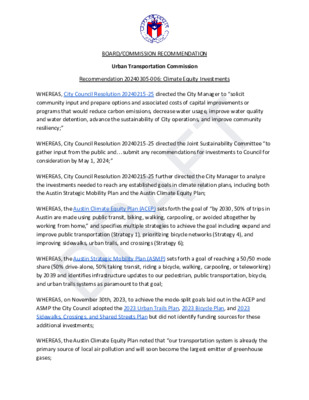06 Climate Equity Investments Recommendation — original pdf
Backup

WHEREAS, City Council Resolution 20240215-25 directed the Joint Sustainability Committee “to gather input from the public and…submit any recommendations for investments to Council for consideration by May 1, 2024;” WHEREAS, City Council Resolution 20240215-25 directed the City Manager to “solicit community input and prepare options and associated costs of capital improvements or programs that would reduce carbon emissions, decrease water usage, improve water quality and water detention, advance the sustainability of City operations, and improve community resiliency;” BOARD/COMMISSION RECOMMENDATION Urban Transportation Commission Recommendation 20240305-006: Climate Equity Investments D R A F T WHEREAS, the Austin Climate Equity Plan (ACEP) sets forth the goal of “by 2030, 50% of trips in Austin are made using public transit, biking, walking, carpooling, or avoided altogether by working from home,” and specifies multiple strategies to achieve the goal including expand and improve public transportation (Strategy 1), prioritizing bicycle networks (Strategy 4), and improving sidewalks, urban trails, and crossings (Strategy 6); WHEREAS, the Austin Strategic Mobility Plan (ASMP) sets forth a goal of reaching a 50/50 mode share (50% drive-alone, 50% taking transit, riding a bicycle, walking, carpooling, or teleworking) by 2039 and identifies infrastructure updates to our pedestrian, public transportation, bicycle, and urban trails systems as paramount to that goal; WHEREAS, City Council Resolution 20240215-25 further directed the City Manager to analyze the investments needed to reach any established goals in climate relation plans, including both the Austin Strategic Mobility Plan and the Austin Climate Equity Plan; WHEREAS, on November 30th, 2023, to achieve the mode-split goals laid out in the ACEP and ASMP the City Council adopted the 2023 Urban Trails Plan, 2023 Bicycle Plan, and 2023 Sidewalks, Crossings, and Shared Streets Plan but did not identify funding sources for these additional investments; WHEREAS, the Austin Climate Equity Plan noted that “our transportation system is already the primary source of local air pollution and will soon become the largest emitter of greenhouse gases; NOW THEREFORE BE IT RESOLVED that the Urban Transportation Commission recommends the Joint Sustainability Committee, City Manager, and City Council consider the following investments to address local causes of climate change by reducing transportation-related carbon emissions: ● $48,960,000 to ensure the City of Austin builds out an additional 148 miles of the All ○ Projects should be selected using the project prioritization model in the 2023 Bicycle Plan, which scores projects based on equity, destinations & travel demand, connectivity & safety, and cost; Ages and Abilities (AAA) Bicycle Priority Network and meets the 2023 Bike Plan Goal of 380 miles built out by 2026 (See ASMP Bicycle Policy 2, ACEP Transportation and Land Use Goal 3, and 2023 Bike Plan Item 4.7.1a); ○ Methodology: The current AAA network buildout is at 232 miles. The Bike Plan estimates that the average protected bike lane costs $600k/mile. The total cost to reach the 2026 goal is $88,800,000. The 2016 and 2020 Mobility Bonds have a total of $39,840,000 in unspent bikeways funds (as of December 5th, 2023); ● $22,600,000 to build out an additional 200 Metro Bike Stations to ensure the City of Austin reaches the 2023 Bike Plan goal of 300 stations by 2025; (See ASMP Shared Mobility Policy 1, ACEP Transportation and Land Use Goal 3, and 2023 Bike Plan Item 4.7.2); D R A F T ● $75,826,000 to build out 15.6 miles of Tier One Urban Trails by 2028 and put the City of Austin on track to reach the 2023 Urban Trails goal of building all 94 miles of Tier 1 trails by 2043 (See ASMP Urban Trails Policy 2 & 3, ACEP Transportation and Land Use Goal 3, and 2023 Urban Trails Plan Section 3.5) Transportation’s Transportation Alternative Set-Aside grant program. Those funds will build 100 new stations, including replacing 83 existing stations, and 800 new electric bicycles; ○ Methodology: The Urban Trails Plan uses the assumption of $10 million per mile. To build out all Tier 1 trails by 2043, Austin needs to average $52 million in Urban Trails spending per year. The 2016, 2018, and 2020 Mobility Bonds contain a total of $80,174,000 in unspent funds for Urban Trails (as of December 5th, 2023); mobility needs and connections to CapMetro’s existing high-frequency bus and Metro Rail network; ○ Methodology: MetroBike received $11.3 million from the Texas Department of ○ The investment should prioritize new stations in low-income areas with high ● $64,000,000 to ensure the City of Austin builds out 136 miles of new sidewalks and 80 miles of shared streets per year through 2028, putting Austin on track to address all “Very High” and “High” priority sidewalks and shared streets within 10 years (See ASMP Pedestrian Network Policy 1 & 2, ACEP Transportation and Land Use Goal 3, and 2023 Sidewalks, Crossings, and Shared Streets Plan Section 2.3.4) ○ Projects in the highest Equity Analysis Zones should be prioritized for funding, per the Sidewalks, Crossings, and Shared Streets Plan ○ Methodology: The Sidewalks, Crossings, and Shared Streets Plan notes the city currently has “less than half the estimated funding required to meet plan goals through 2028”. Those goals are spending $32 million for 34 miles of new sidewalks and 20 miles of shared streets annually. Over four years that amounts to $128,000,000. - NOW THEREFORE BE IT RESOLVED that the Urban Transportation Commission recommends that these investments be considered a bridge investment to ensure adequate funding to reach our short-term mobility goals and that the City Council direct staff to develop a plan for future funding strategies to ensure Austin can reach our long-term mobility goals; Motioned by: Seconded by: Date of Approval: Record of the vote: Attest: _____________________________________________ (Staff or board member can sign) D R A F T